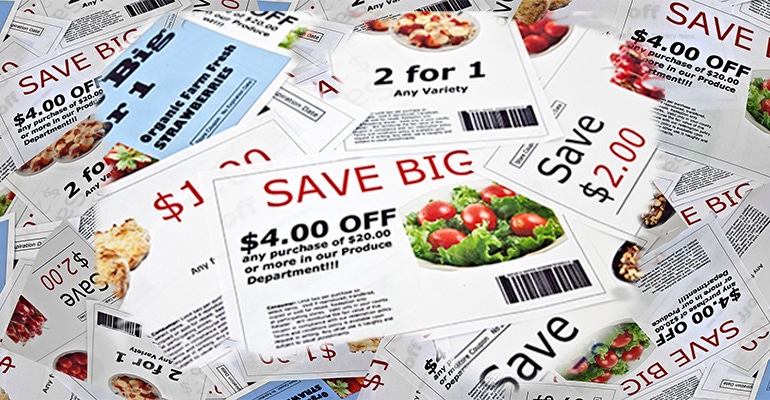November 12, 2020

In today’s digital world, do shoppers clip coupons anymore? Do they even look at mailings from grocery stores before recycling them? Turns out, yes.
“Talking to consumers about their purchasing influencers, direct mailings from grocery stores—whether weekly circulars or paper coupons—still have a lot of influence,” says Sarah Marion, Ph.D., director of syndicated research at Murphy Research. “Many people plan their shopping trips around these items, so they are very important.” Plus, as Marion points out, email inboxes are typically more cluttered with junk than physical mailboxes these days, making a strong case for including hard-copy marketing materials into your overall communications strategy. That said, anything you mail out must pack a punch and entice recipients to engage. (And you can make promotions profitable.) Here’s how to nail it.
 Promotions expert
Promotions expert

Nick Auzenne,
director of purchasing at Independent Natural Foods Retailers Association,
St. Paul, Minnesota
Try targeted versus mass direct mail.
Print is definitely still important—I just think it’s moving in new directions. Rather than mass-mailing a traditional circular or flier to 10,000 or 20,000 people, retailers are looking at different print options, whether couponing or specifically targeting new move-ins. If your goal is to grow foot traffic and attract new customers, targeted mailing is a much better strategy and spend. There are still opportunities for mass mailing, but it must be very focused. For example, instead of a monthly circular, send out quarterly mailings that feature really good deals and focus on a major holiday.
Include a coupon tracking tool.
The thing about print versus digital is if you distribute, say, 10,000 fliers a month, how do you know how many were followed through on? To gauge engagement, include something in the materials that you can track. A coupon that shoppers can bring into the store, for example, tells you that for 10,000 fliers sent out, X coupons were redeemed. Now you have metrics on effectiveness. Then, if you’re not getting the engagement you expect, tweak your strategy. Is the issue your content? Your delivery? What can you do to garner more engagement?
Make coupons worth it.
With the current economic landscape and recession on the horizon, I think couponing will be increasingly important and people will look for those opportunities to save. What makes couponing harder now is shoppers are making fewer store visits—and will continue to—and they’re no longer clipping coupons for and visiting three different stores. Taking that into account, be sure to offer good enough deals that they choose your store and show your ability to complete their basket. Know the competition around you, offer the best deal you can to ensure folks won’t pass on putting something in their basket because they know they can get it much cheaper elsewhere.
 Market researcher
Market researcher

Sarah Marion, Ph.D.,
director of syndicated research at Murphy Research,
Santa Monica, California
Provide the tactile experience consumers crave.
Grocery shopping is physical and tactile, and while COVID-19 has shifted more of it online, consumers still enjoy shopping in person. Most people still make lists, too—on paper, despite all the list apps out there—which lends itself well to physical mailers or coupons, which require similar tactile actions. Plus, people are spending more time at home now, creating more opportunities for engagement with these materials and making the physicality of them important. Knowing they come along with other mail, choose nice card stock, get creative with size and colors, and make sure it doesn’t look like a bill.
Win with personalized paper coupons.
Personalized promotions get a lot more engagement than general ones. In fact, younger shoppers even expect direct mail to be personalized. Most stores today collect loyalty data and sending out personalized coupons for items a shopper already buys—and other products they might want to buy—is a great way to use that data to delight consumers. I suspect that during COVID, without the ability to browse and sample, coupons are even more important for first-time trial. They are low stakes but get products in front of consumers, which is much harder to do in-store these days.
Deliver education.
Natural products consumers tend to engage more with retailers’ communications because they have reasons beyond food to shop there. A store might align with their values, for instance, or research products for them. Therefore, your communications shouldn’t focus solely on promos and coupons; do educational mailings as well. Your customers want to know how you vet products, where your chicken comes from, how you deal with issues in the food world and, during COVID, how you’re caring for staff and managing in-store safety.

Retailer
Tim O’Brien,
owner of The Healthy Place,
Greater Madison, Wisconsin
Send standalone items.
For us, direct mail has been an effective strategy, with some efforts working better than others. We’ve done newspaper wraps and coupons in magazines, but sending out postcard coupons has been the most successful, with about a 0.5% return. As a standalone item, a postcard has more power. If someone throws it away, they’ll at least look at it first, and if they clip the coupon, they can stick it on their fridge or tuck it away in a drawer. It’s like having a gift card in your wallet: You keep seeing it and are reminded to spend it. When coupons are digital, they just feel more distant or harder to use—or they’re just deleted right away.
Test first, expand later.
We send out 100,000 postcards at a time, but I’d never encourage starting there because it’s not cheap! Start small. Send out your materials to a limited number first, maybe 25,000 households, depending on the size of your town. Test it, see if it’s working and then double down. Most postcard companies have strategies to help you. Ours will pick ZIP codes they think will be most successful for a campaign based on demographics or distance from stores, and they’ll change up the formula over time. It’s also key to negotiate a good price on postcards.
No profit, no problem.
With any mailed coupon, your strategy shouldn’t be to make a profit on that specific campaign. The goal is to make people fans of your brand so they’ll keep coming back. If you are profitable, great, but breaking even is still a big win because gaining new customers is how you get ahead. With our postcard coupons, the goal is to get customers into our stores, because then conversations happen, other conditions are brought up and more products are purchased. But the biggest thing is having a strong enough offer to ensure they’ll come in. Ours is $20 off a $40 purchase.
About the Author(s)
You May Also Like
.png?width=700&auto=webp&quality=80&disable=upscale)




